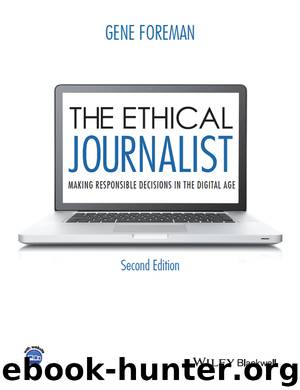The Ethical Journalist: Making Responsible Decisions in the Digital Age by Gene Foreman

Author:Gene Foreman [Foreman, Gene]
Language: eng
Format: azw3
ISBN: 9781119031765
Publisher: Wiley
Published: 2015-06-02T04:00:00+00:00
However, the journalist’s sense of healthy skepticism is vital in screening social-media content. When Hurricane Sandy hit the East Coast in October 2012, an image of an ominous, circular cloud above the Statue of Liberty was tweeted thousands of times. Professionals debunked the image as a composite that had appropriated a cloud photographed in Nebraska in 2004 by a stormchaser, Mike Hollingshead. Another faked cloud photo, this one over the Manhattan skyline, was popular on Instagram. Even a real photo being circulated was phony in another way. A picture of soldiers guarding the Tomb of Unknown Soldier in a driving rain was presented as having been taken during the hurricane, but an image search showed that it was taken a month before Sandy hit.39 Two images of sharks swimming in flooded streets in New Jersey after the hurricane also went viral on Twitter but were exposed as Photoshopped fakes.40
In 2013 a photograph of a giant beach ball on a London street during a driving rain was offered to The Guardian’s open-journalism platform, which allows readers to share their images and stories. It put the editors on guard against being hoaxed, because, as they said, the picture looked “too good to be true.” Yet, after a rigorous check, they found it was indeed true. Until the storm, the ball – as tall as a double-decker bus – had been tethered to a building nearby. The bizarre image made for fascinating photojournalism.41
A Case Study accompanying this chapter, “Verifying a Key Boston Video,” shows how professionals go about the task of testing the authenticity of social-media content that, if true, would be of news value.
Crowdsourcing is helping journalists develop important stories. In 2013 Elisabeth Rosenthal of The New York Times undertook a series of articles investigating why health costs in the United States were so much higher than in other developed countries. After her first story, about a woman who paid more than $6,000 for a routine colonoscopy that would cost under $1,000 elsewhere, the rest of Rosenthal’s series told the personal stories of people who sent her online comments.42 Those comments were solicited with the reporter’s direct questions, such as “Tell us about an experience in a hospital that you thought was – or wasn’t – worth the charges.” Rosenthal told Margaret Sullivan, the paper’s public editor, that she had received tens of thousands of comments: “They are a wonderful and intelligent resource for me, as a reporter. And they do keep you honest, as people bring up interesting objections to your ideas.”43
In covering a tornado that hit their city on April 27, 2011, and killed 53 people, journalists of The Tuscaloosa (Alabama) News coped with an active rumor mill: “Bodies in the lake. Bodies on top of the mall. Bodies hidden by city officials in a locker somewhere outside of town.” None of the stories were true. To investigate the most persistent rumors, The News created a blog that tried to find out where they came from, to get the facts from public officials, and to update information quickly.
Download
This site does not store any files on its server. We only index and link to content provided by other sites. Please contact the content providers to delete copyright contents if any and email us, we'll remove relevant links or contents immediately.
Asking the Right Questions: A Guide to Critical Thinking by M. Neil Browne & Stuart M. Keeley(5357)
Autoboyography by Christina Lauren(5088)
Dialogue by Robert McKee(4160)
Eat That Frog! by Brian Tracy(4149)
Sticky Fingers by Joe Hagan(3912)
Journeys Out of the Body by Robert Monroe(3461)
Annapurna by Maurice Herzog(3300)
Full Circle by Michael Palin(3268)
Elements of Style 2017 by Richard De A'Morelli(3237)
Schaum's Quick Guide to Writing Great Short Stories by Margaret Lucke(3188)
The Art of Dramatic Writing: Its Basis in the Creative Interpretation of Human Motives by Egri Lajos(2858)
The Diviners by Libba Bray(2801)
Why I Write by George Orwell(2775)
The Mental Game of Writing: How to Overcome Obstacles, Stay Creative and Productive, and Free Your Mind for Success by James Scott Bell(2766)
In Patagonia by Bruce Chatwin(2755)
Atlas Obscura by Joshua Foer(2706)
The Fight by Norman Mailer(2702)
Venice by Jan Morris(2431)
The Elements of Style by William Strunk and E. B. White(2377)
